LANL update to
$^{239}$Pu
in the fast energy range

LA-UR-21-31243
Matthew Mumpower
Denise Neudecker

Nuclear Data Team

Los Alamos National Laboratory Caveat
The submitted materials have been authored by an employee or employees of Triad National Security, LLC (Triad) under contract with the U.S. Department of Energy/National Nuclear Security Administration (DOE/NNSA).
Accordingly, the U.S. Government retains an irrevocable, nonexclusive, royaltyfree license to publish, translate, reproduce, use, or dispose of the published form of the work and to authorize others to do the same for U.S. Government purposes.
Summary of current status: updates since ENDF/B-VIII.0
We are in the process of updating the $^{239}$Pu cross sections in the fast energy range
(complementing the work of IAEA / INDEN / ORNL lower energy work in the resonance range)
LANL has been overhauling its evaluation tools (CoH, CGMF, DeCE, Kalman, NEXUS, PySOK, SOK)
Focus on consistency throughout evaluation (we are evaluating more isotopes)
Model update: new collective enhancement allows for simultaneous description of (n,f) and (n,2n) channels
Model update: new inelastic scattering model using the Engelbrecht-Weidenmuller transformation
New cross section evaluation goes up to 30 MeV (as well as nu-bar and PFNS)
New (n,$\gamma$) data from S. Mosby up to ~1 MeV
Neutron Data standards $^{239}$Pu(n,f) cross section;
includes updates in covariances with templates and new (n,f) data from fissionTPC (Snyder)
New nu-bar including improved exp. UQ, Marini data and consistent CGMF modeling
New PFNS: INDEN non-model evaluation at thermal, Los Alamos model evaluation above including new Chi-Nu and CEA data
We are actively testing the file versus integral benchmarks; starting covariances
Total cross section
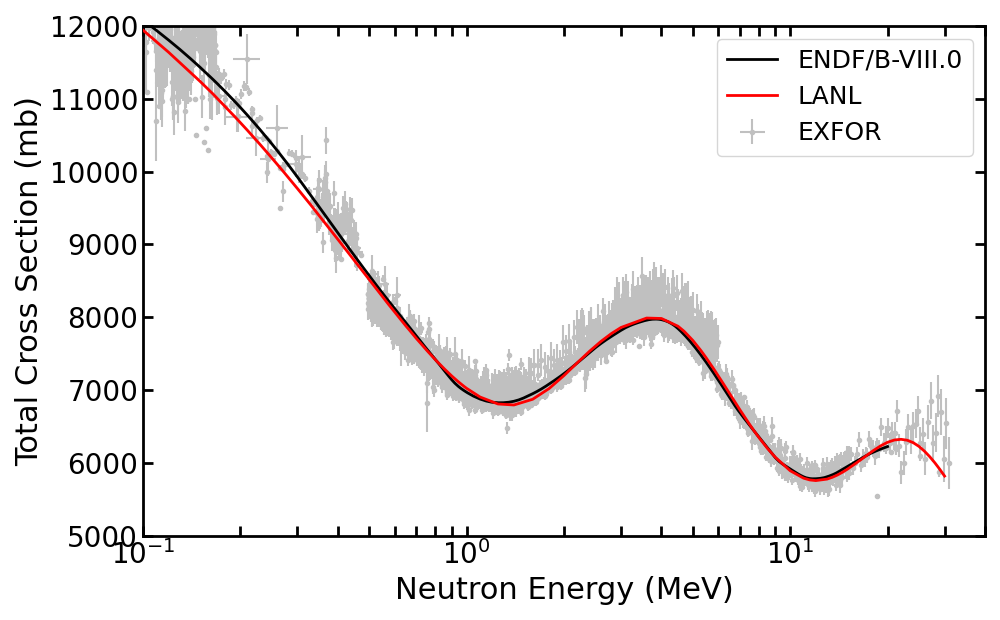
Model: Soukhovitskii (2005) optical model [deformation ~0.21]; coupled channels with 7 levels
Tuned parameters using Bayesian Hyperparameter Optimization to fit to ENDF/B-VIII.0 and parsed EXFOR compilation
Bayesian optimization of parameters
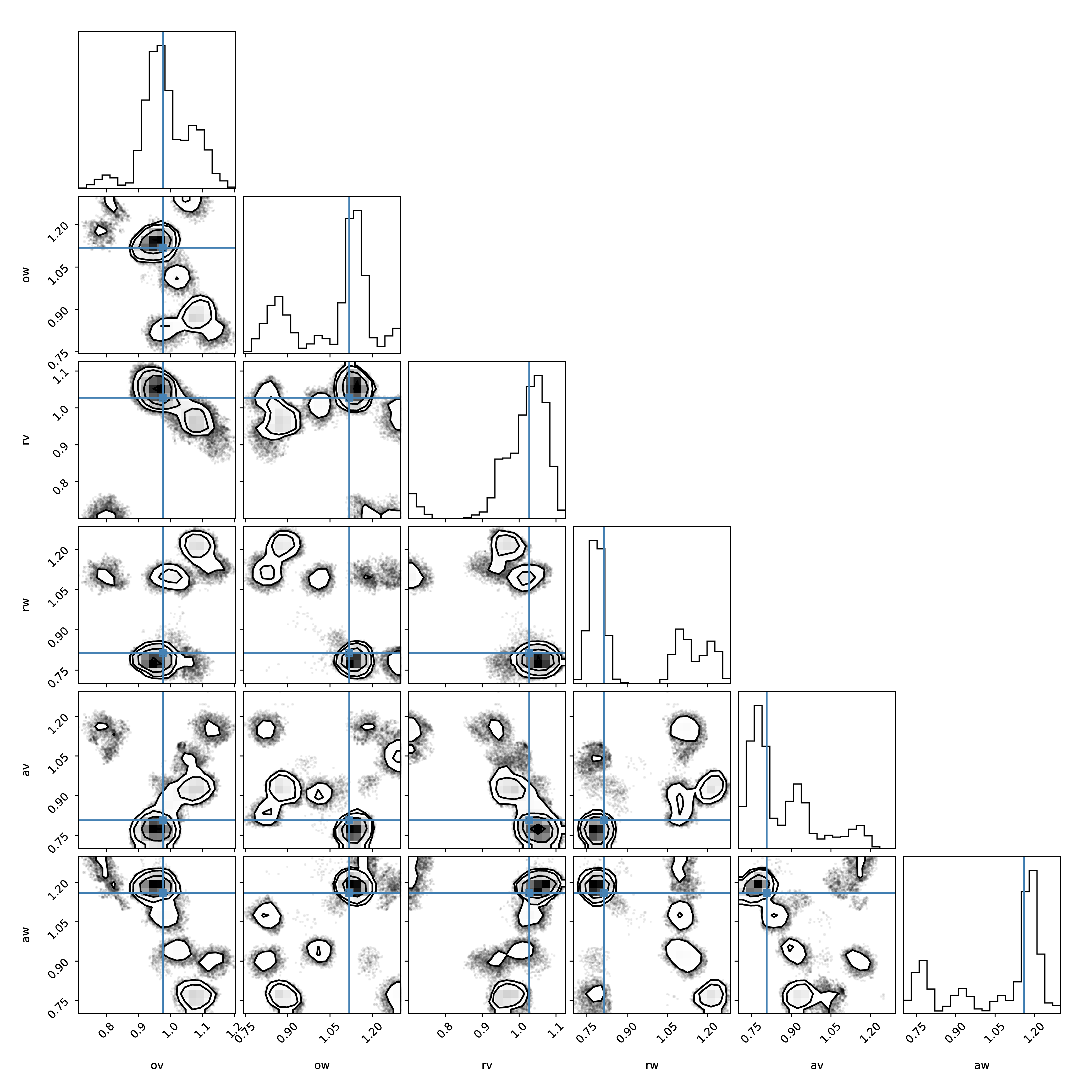
We fit the Soukhovitskii (2005) optical model parameters
(potential depths, radii and diffuseness)
Bayesian optimization of parameters
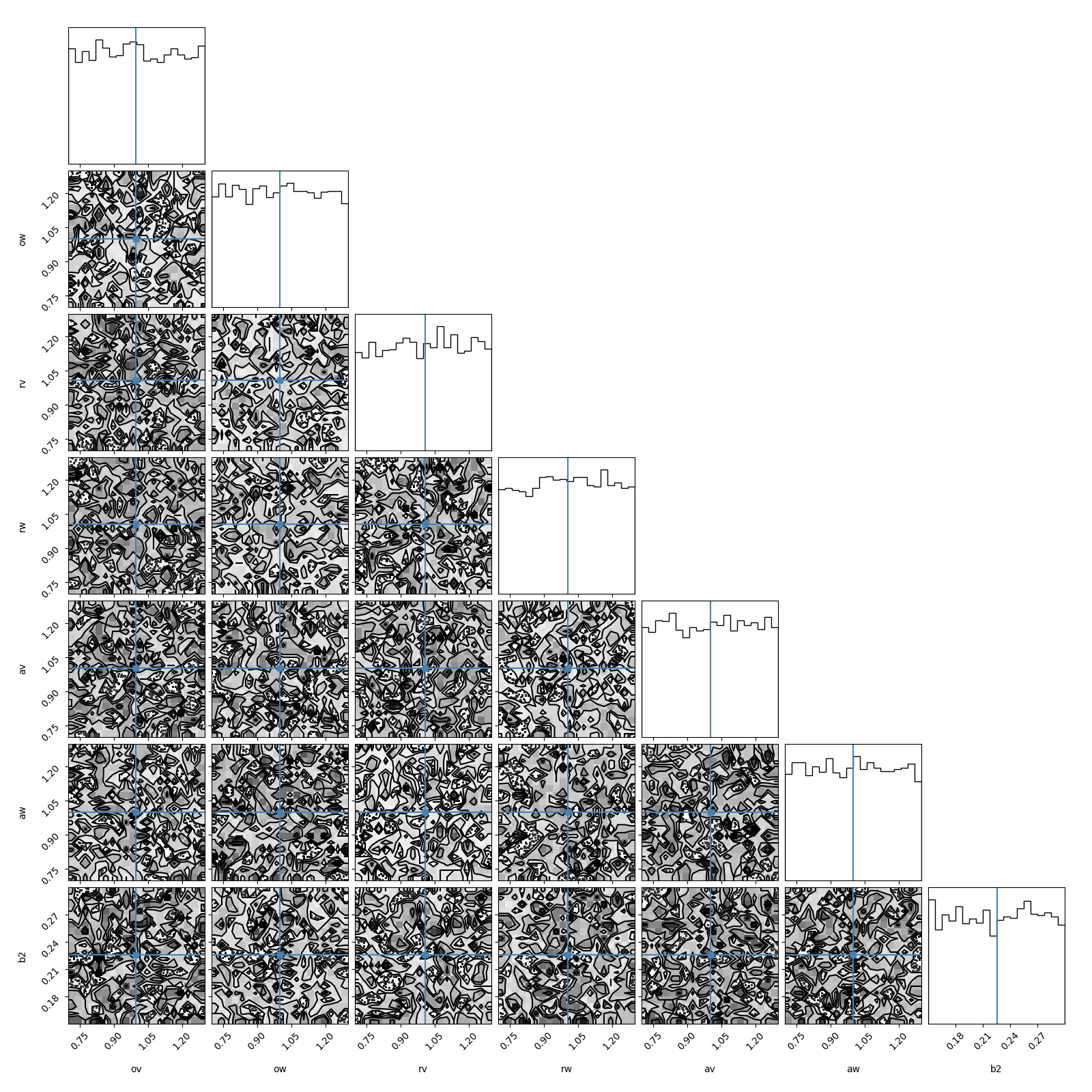
Soukhovitskii (2005) also depends on deformation, but it is not well constrained given cross section data
A cautionary tale; higher dimensional spaces are tricky; holding fixed some parameters is necessary
Capture cross section
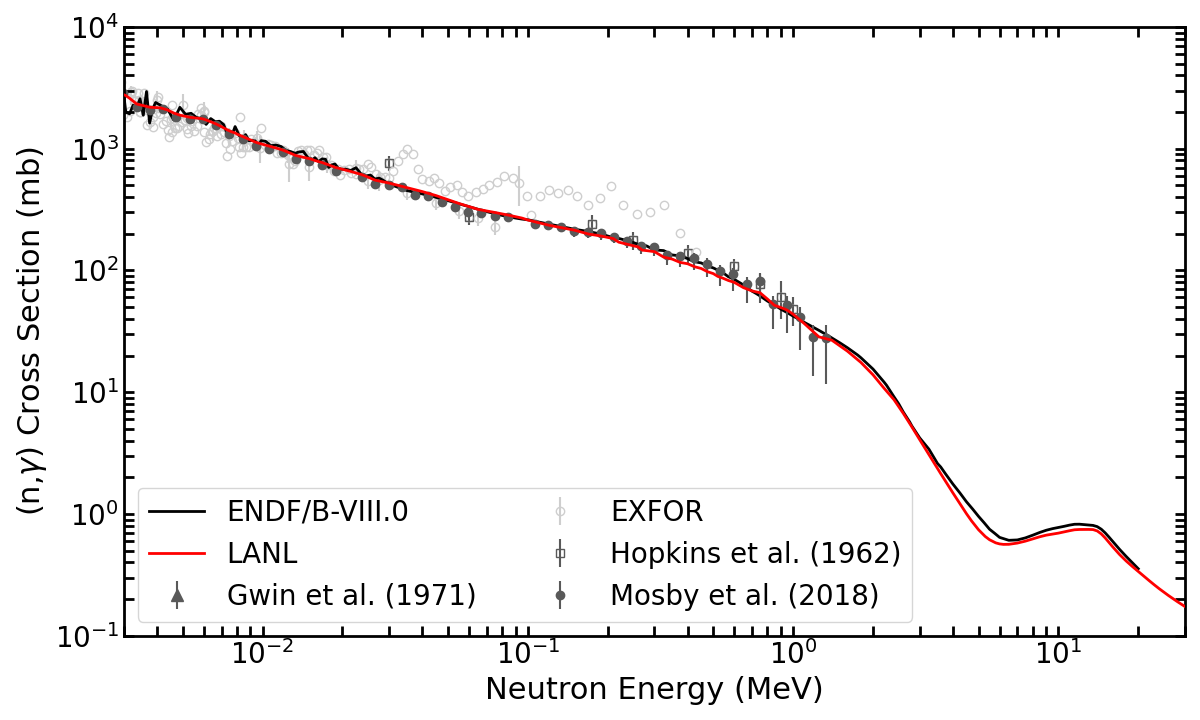
Model: M1 enhancement employed from systematics of Mumpower et al. PRC 96 024612 (2017)
New cross section data incorporated from S. Mosby et al. NDS 148 312 (2018)
Capture cross section ratio
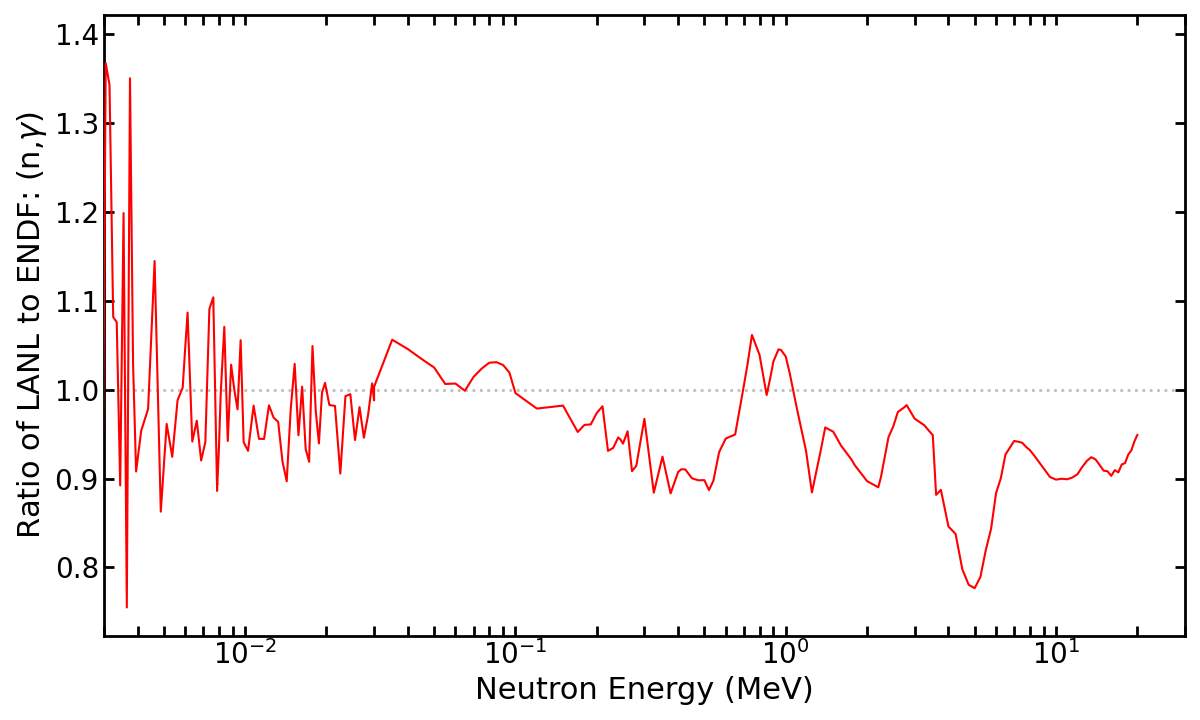
ENDF/B-VIII.0 has some oscillatory behavior around 10 keV
The LANL CoH model in contrast is rather smooth; in agreement with Mosby data
(n,2n) cross section
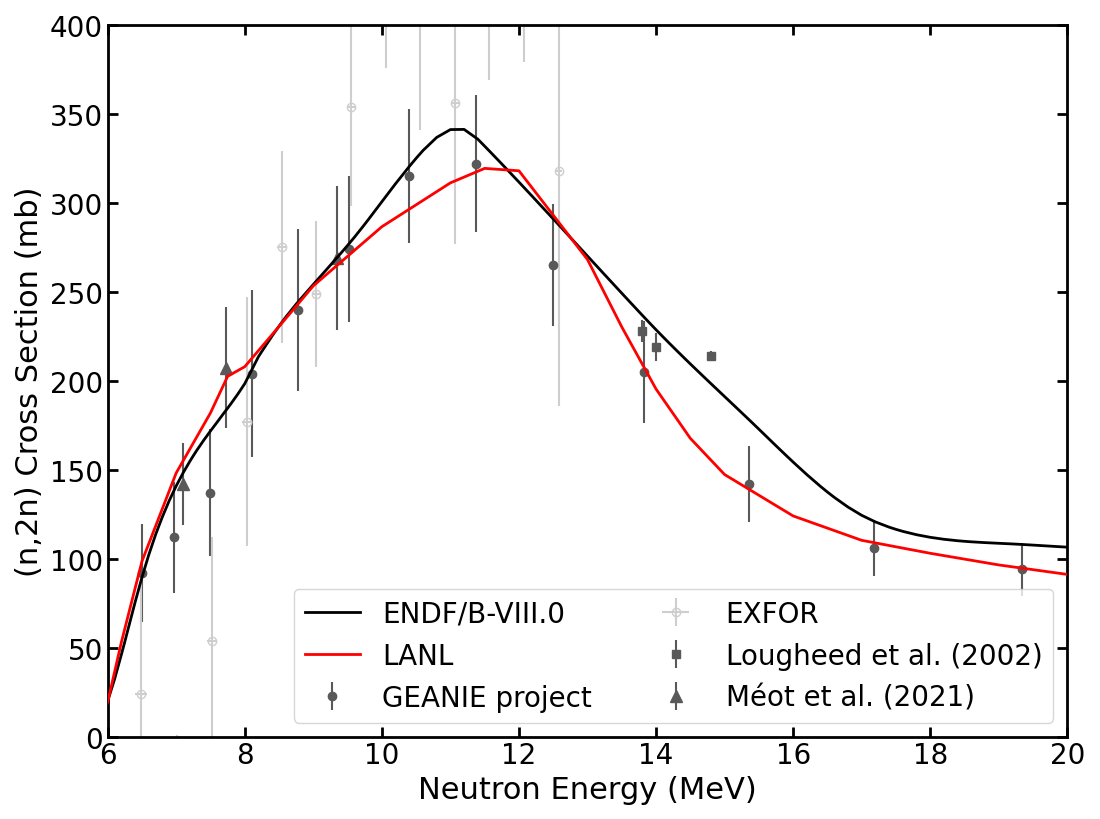
Model: new collective enhancement allows for simultaneous description of (n,f) and (n,2n) channels
[difficult to describe in past versions of CoH]
Tight integration of model and experimental data leads to the updates relative to ENDF/B-VIII.0
we are actively testing this change
(n,2n) cross section ratio
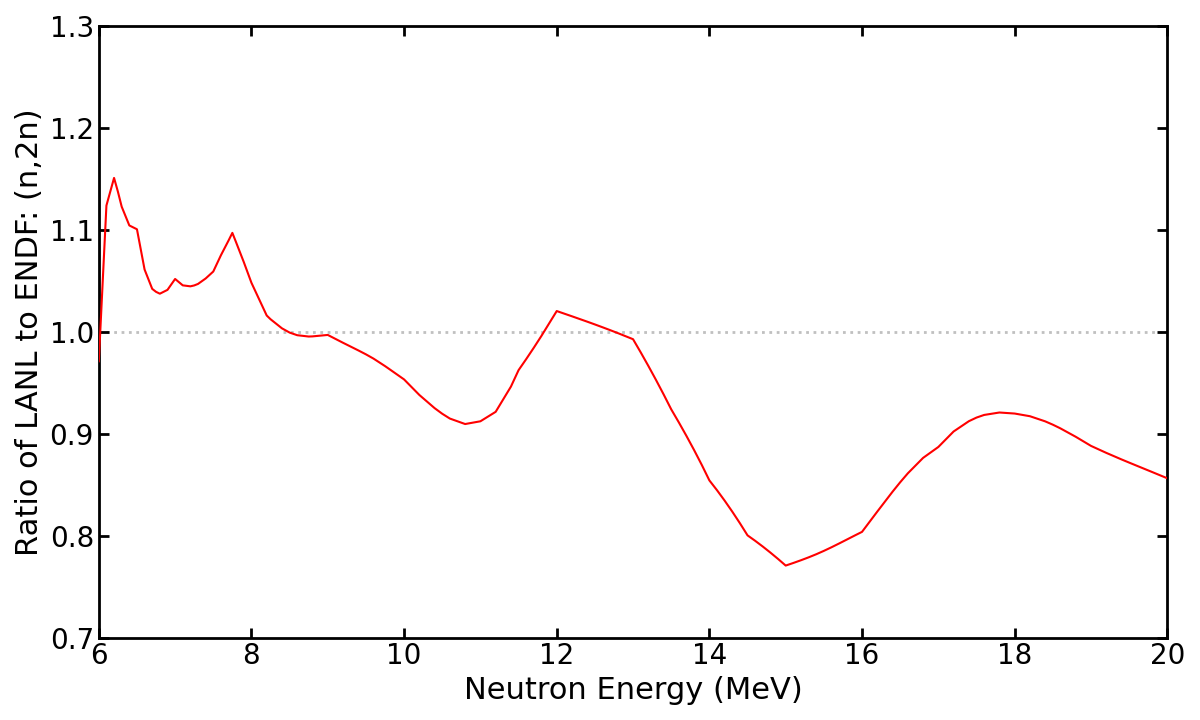
Model: new collective enhancement allows for simultaneous description of (n,f) and (n,2n) channels
[difficult to describe in past versions of CoH]
Tight integration of model and experimental data leads to the updates relative to ENDF/B-VIII.0
we are actively testing this change
Elastic cross section
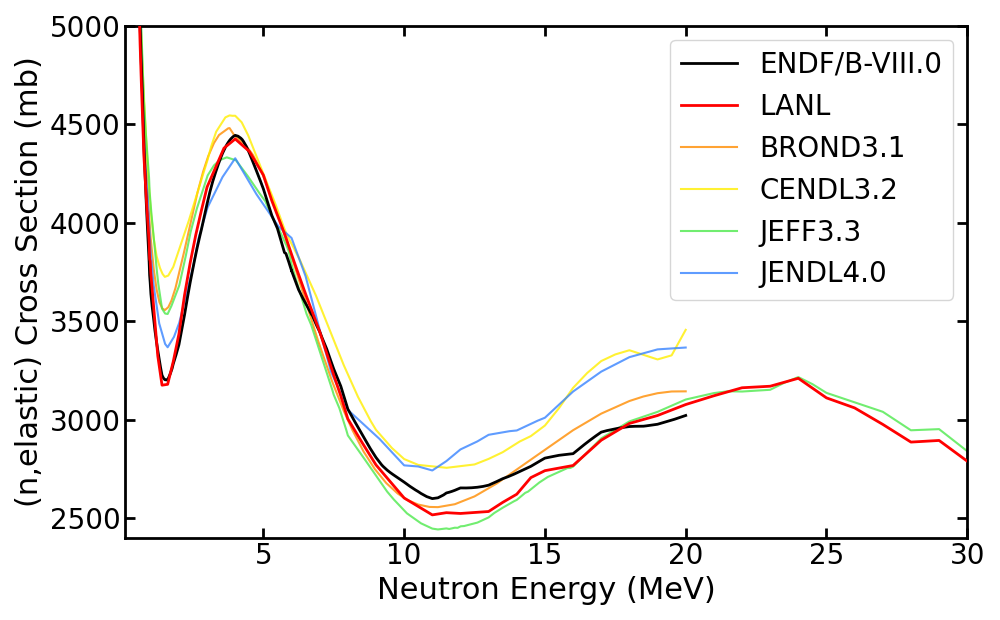
Model: generally tracks ENDF/B-VIII.0 with more substantial differences above 10 MeV
Note that there is a large spread in evaluations as compared to other channels
Inelastic cross section
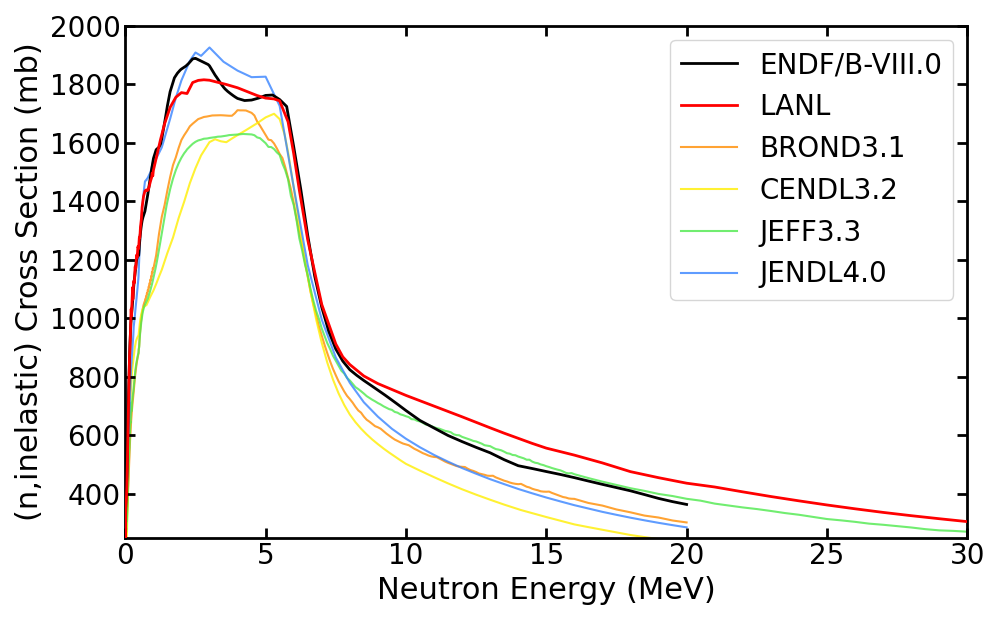
Model: new inelastic scattering model using the Engelbrecht-Weidenmuller transformation
(collective enhancement → removal of fictitious levels); similar to IAEA results
Again, a large spread in evaluations as compared to other channels
Inelastic cross section logscale
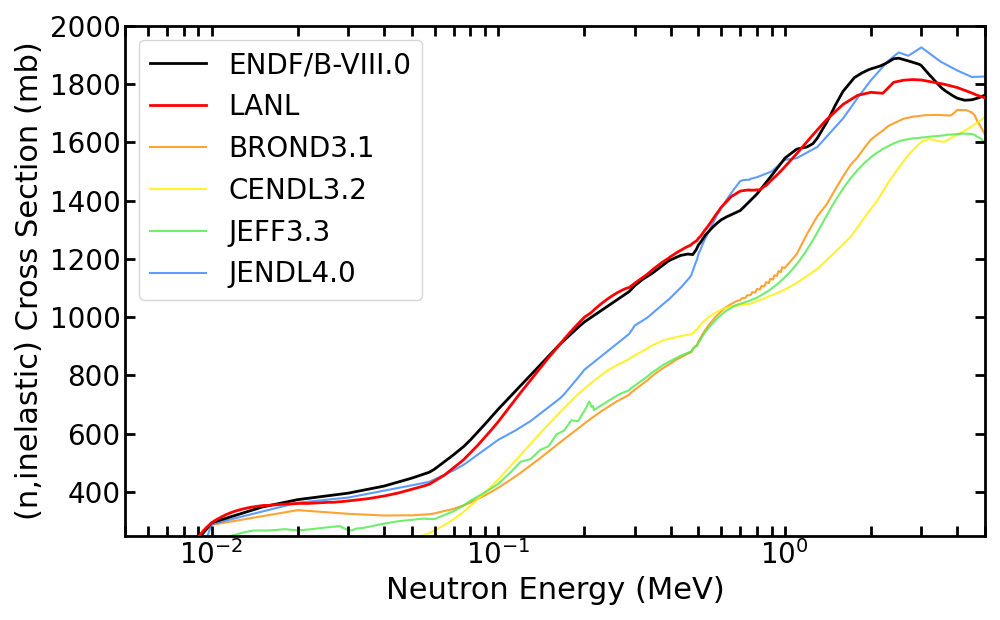
Model: new inelastic scattering model using the Engelbrecht-Weidenmuller transformation
(collective enhancement → removal of fictitious levels); similar to IAEA results
Threshold behavior is similar to ENDF/B-VIII.0 [logscale between 5 keV and 5 MeV]
Elastic cross section
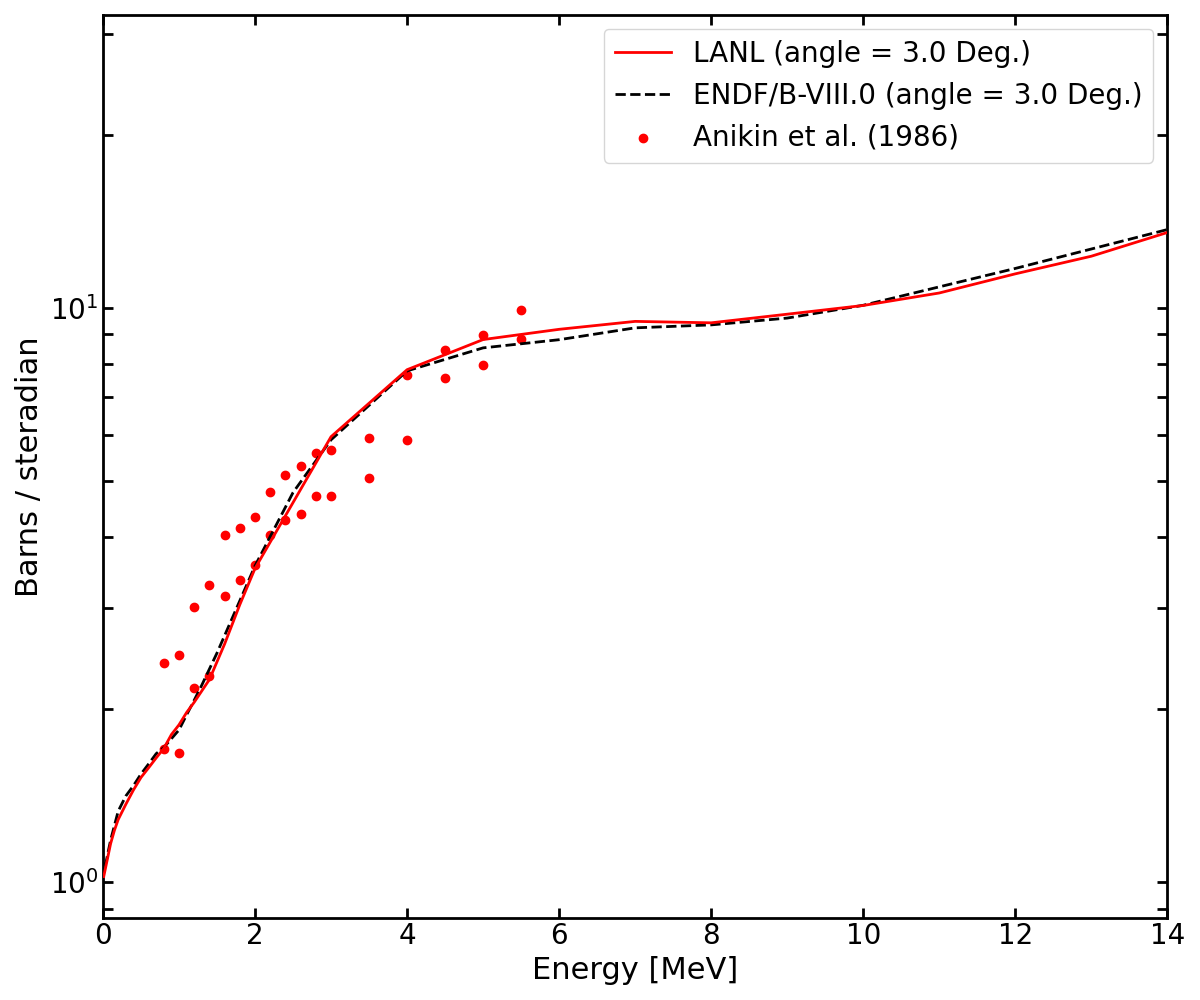
Performs similar to ENDF/B-VIII.0 @ 3 degree
Inelastic cross section
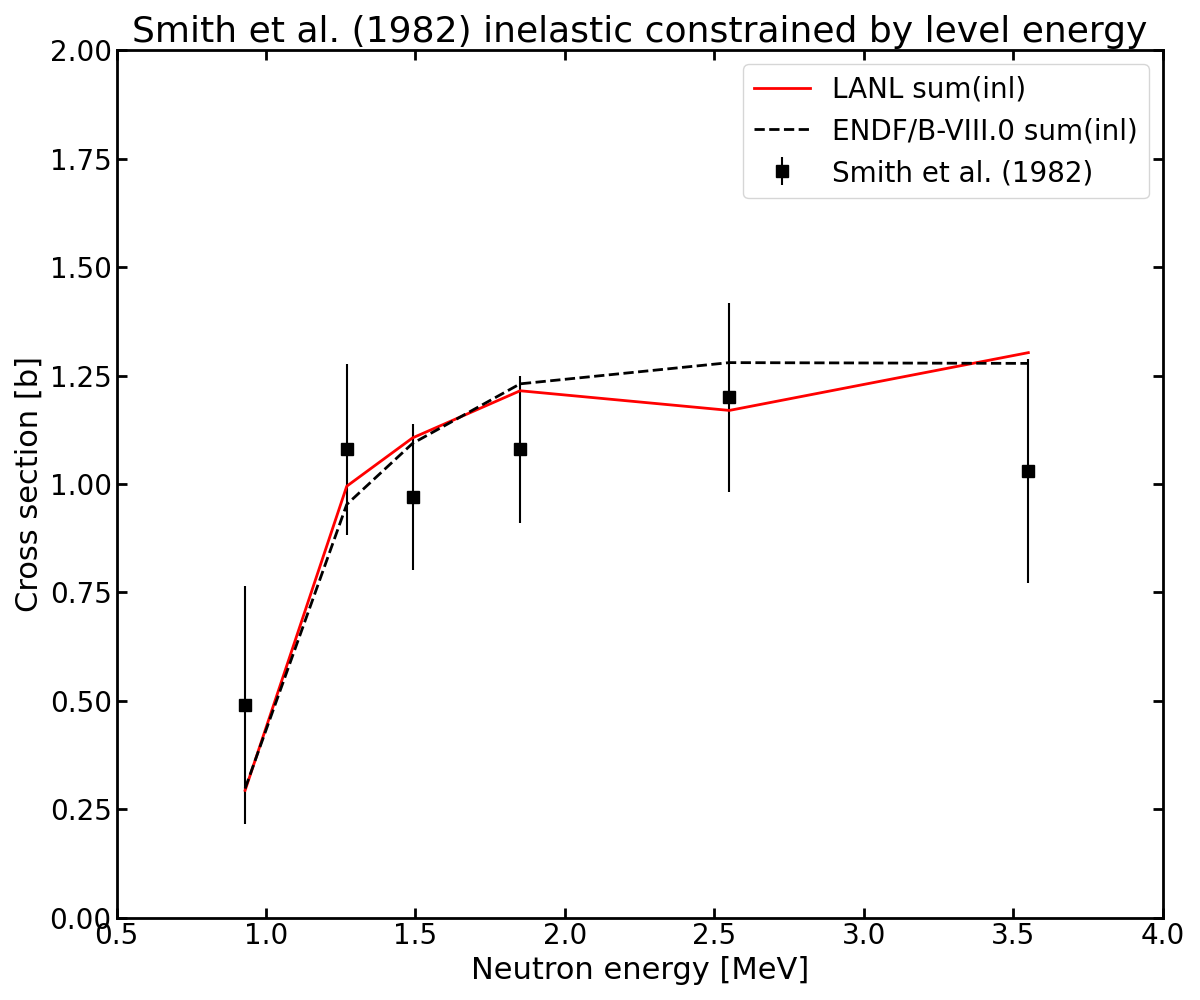
Performs similar to ENDF/B-VIII.0; Excitation energy between 0.08 and 0.3 MeV; energy resolution not quoted
Elastic plus inelastic angular distribution
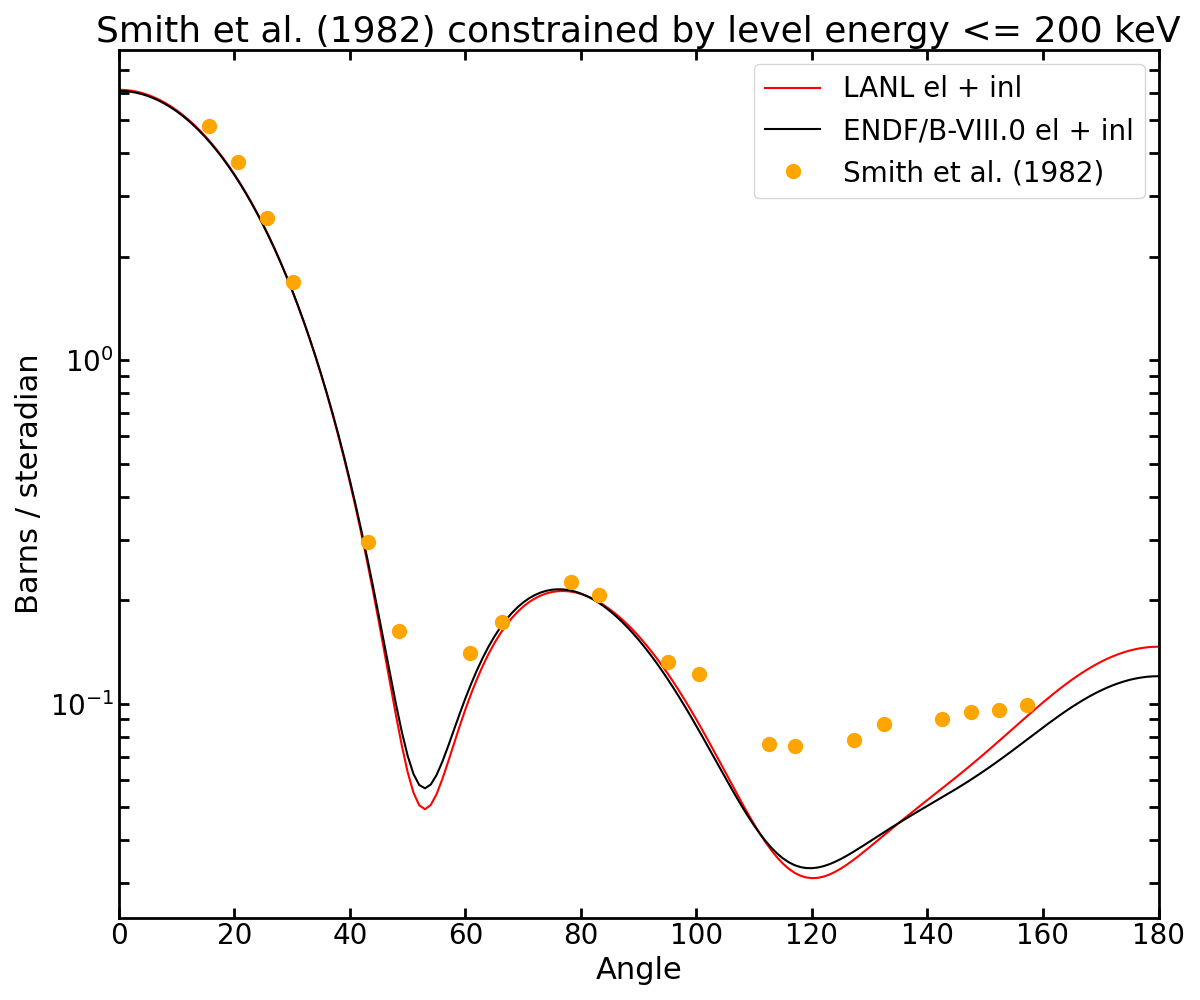
Performs similar to ENDF/B-VIII.0; Incident neutron energy 2.5 MeV; 7 levels under 200 keV
quoted 3% exp. uncertainty
Elastic plus inelastic angular distribution
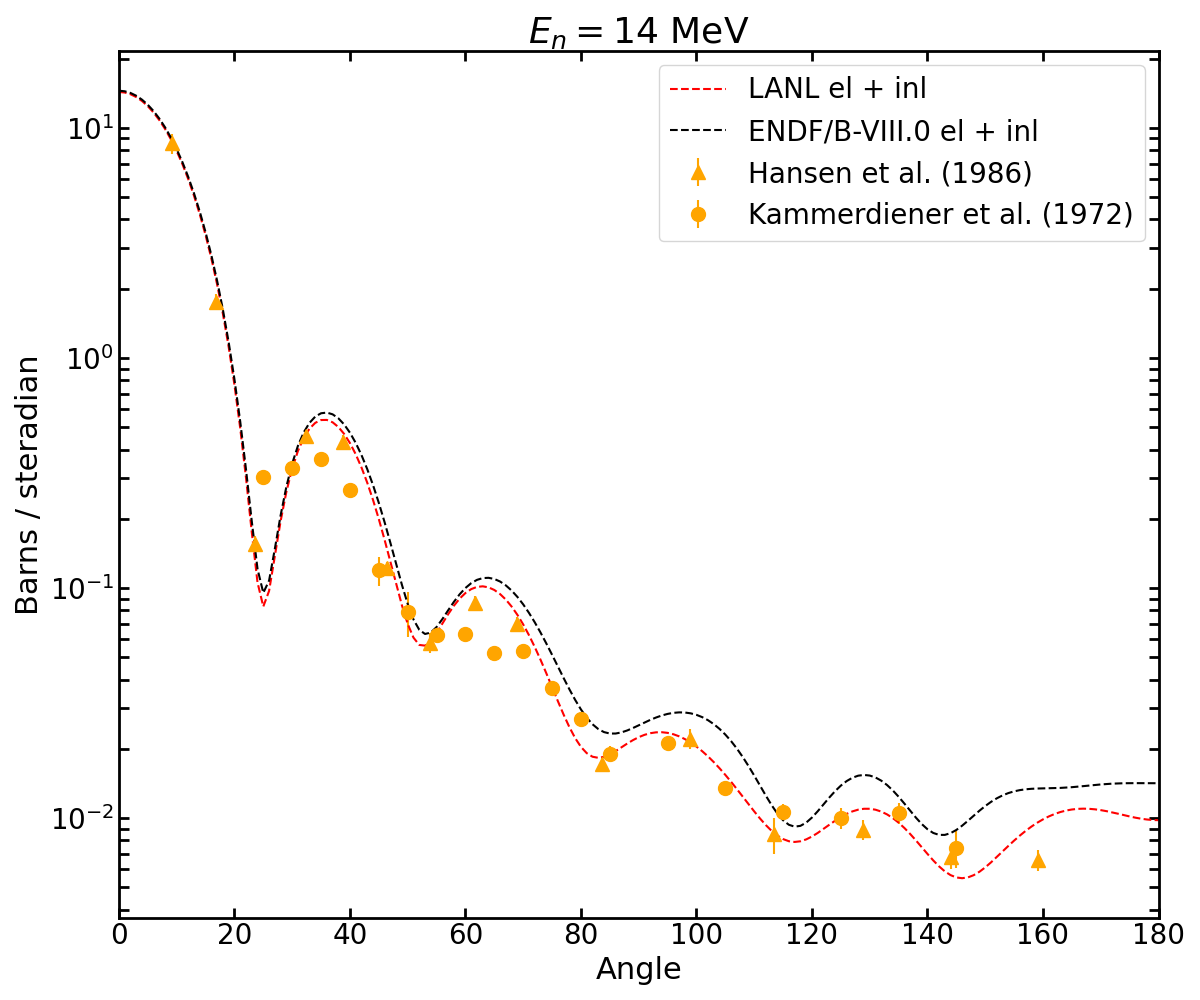
We seem to perform slightly better than ENDF/B-VIII.0 @ 14 MeV; Kammerdiener energy resolution ~1 MeV
Neutron spectrum
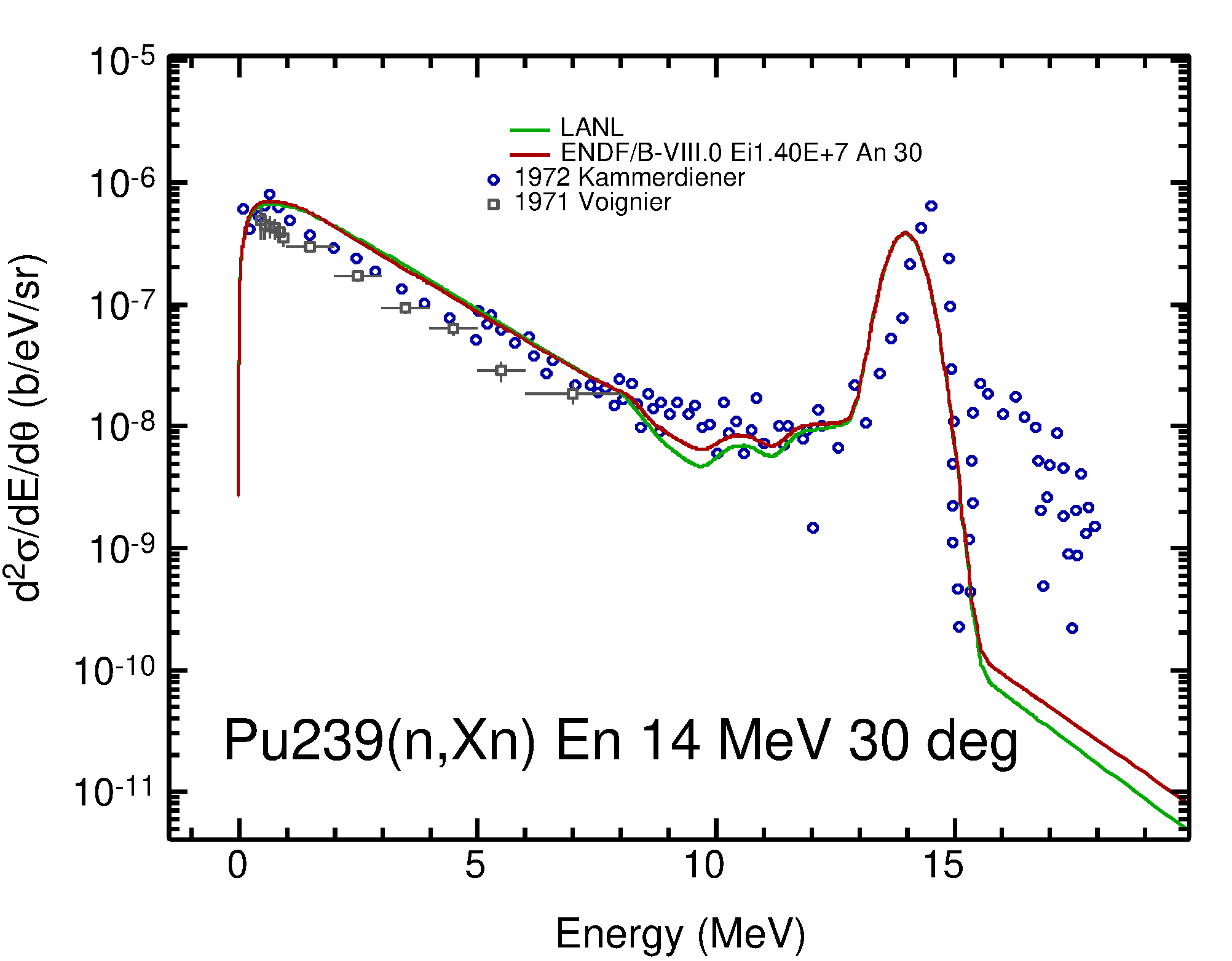
Use of Madland-Nix model; performs similar to ENDF/B-VIII.0
Collective enhancement will be an upgrade (increase green curve); not shown here
Fission cross section
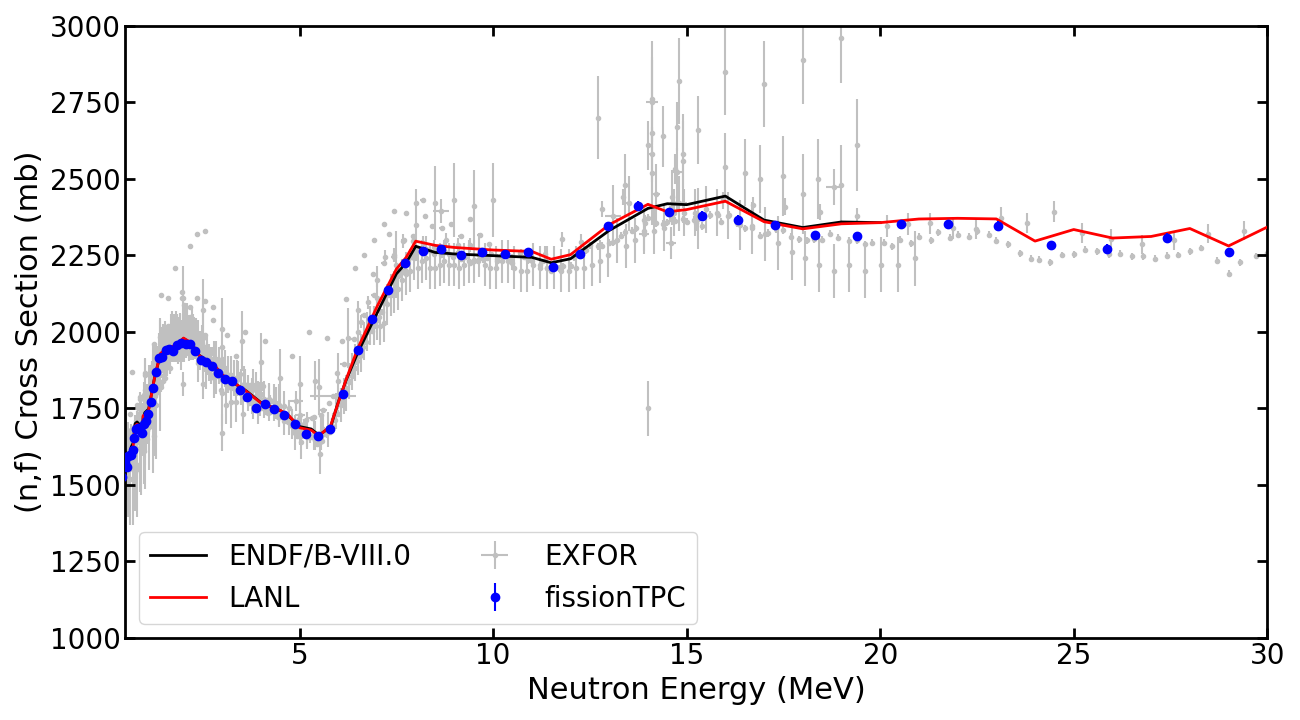
This evaluation differs from the VIII.0 (n,f) cross section; it comes out of standards analysis including updated covariances using the template approach and fissionTPC data; it is a reference cross section.
Our evaluation goes up to 30 MeV (part of the IAEA standards effort)
Fission cross section
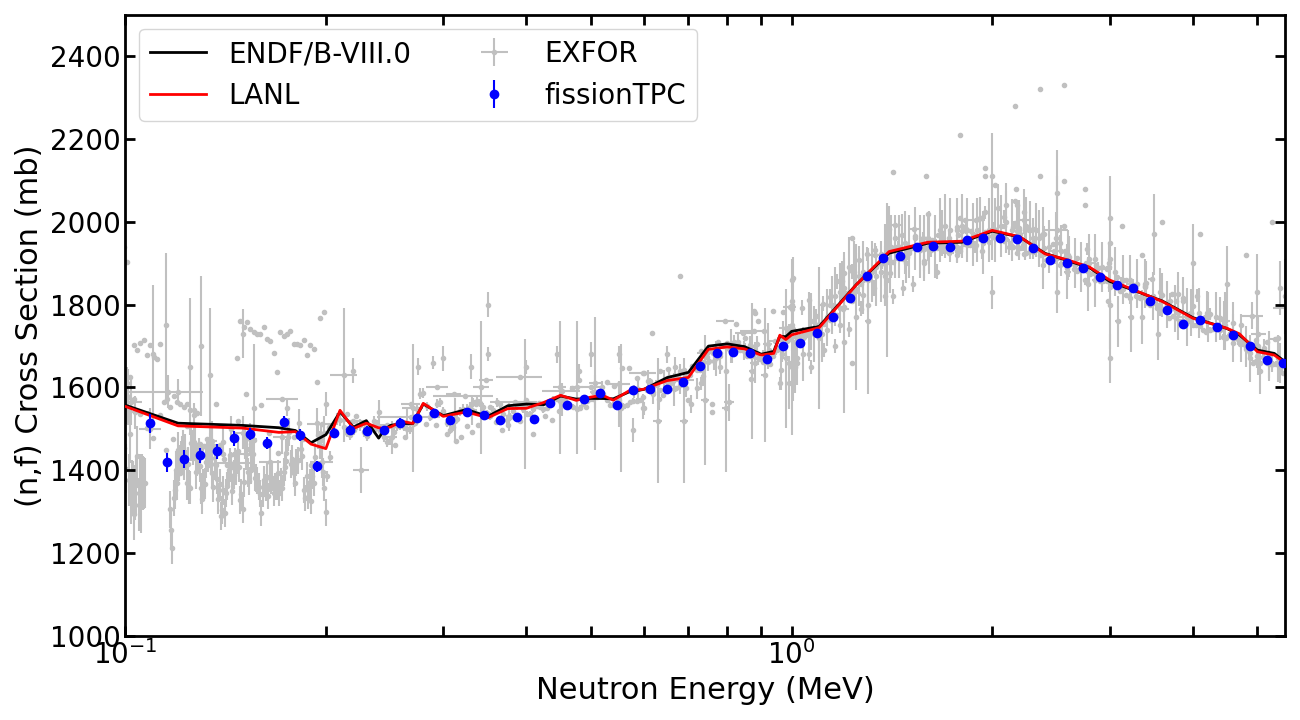
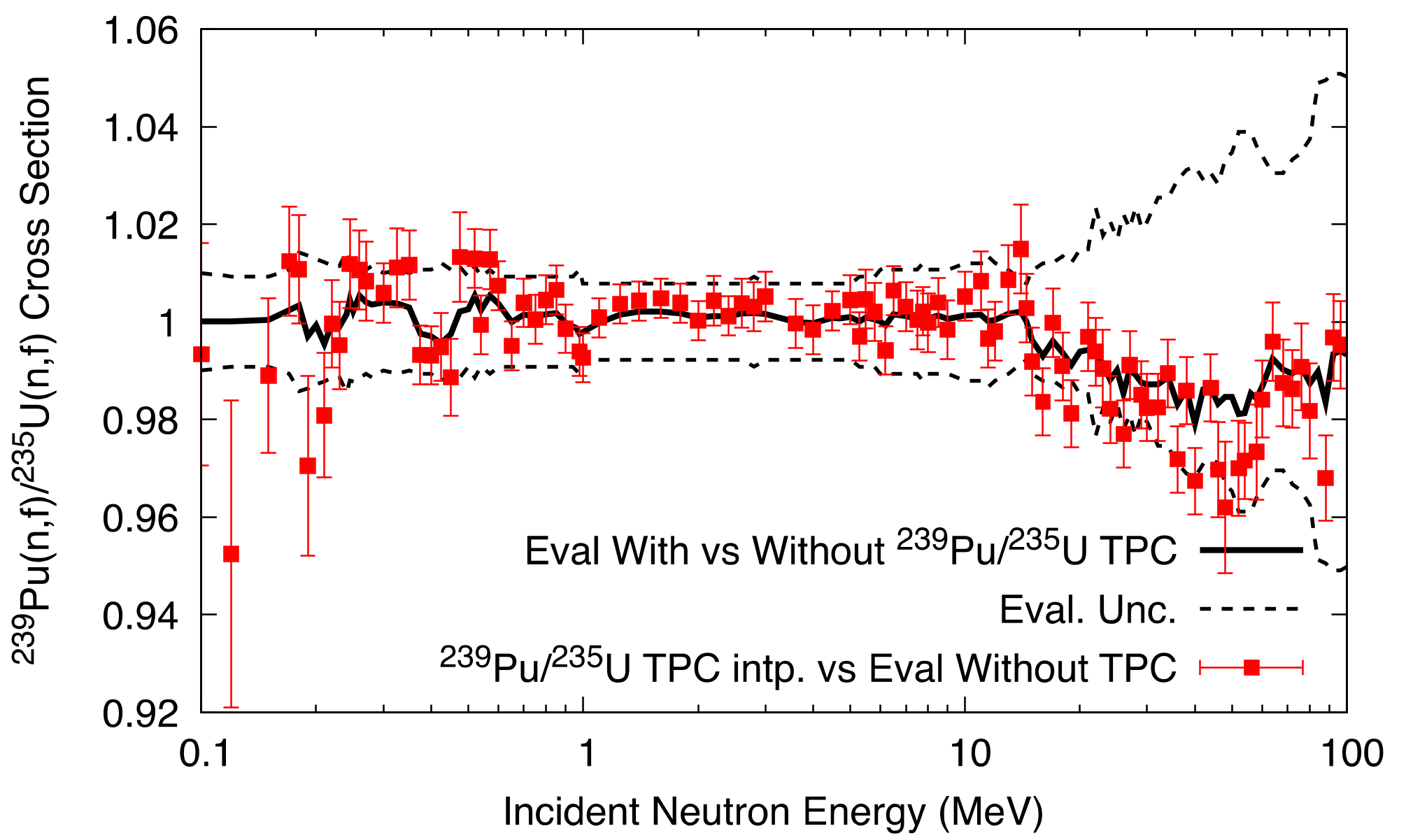
Cross sections in the fast range are similar to ENDF/B-VIII.0
High-precision data by fissionTPC (used as shape) confirms overall trend of fission-chamber measurements
Standards are discussing the normalization factor published by fissionTPC data and how it relates to spectral indices in LANL fast critical assemblies
Right figure shows the impact of fissionTPC data only
Prompt nu-bar
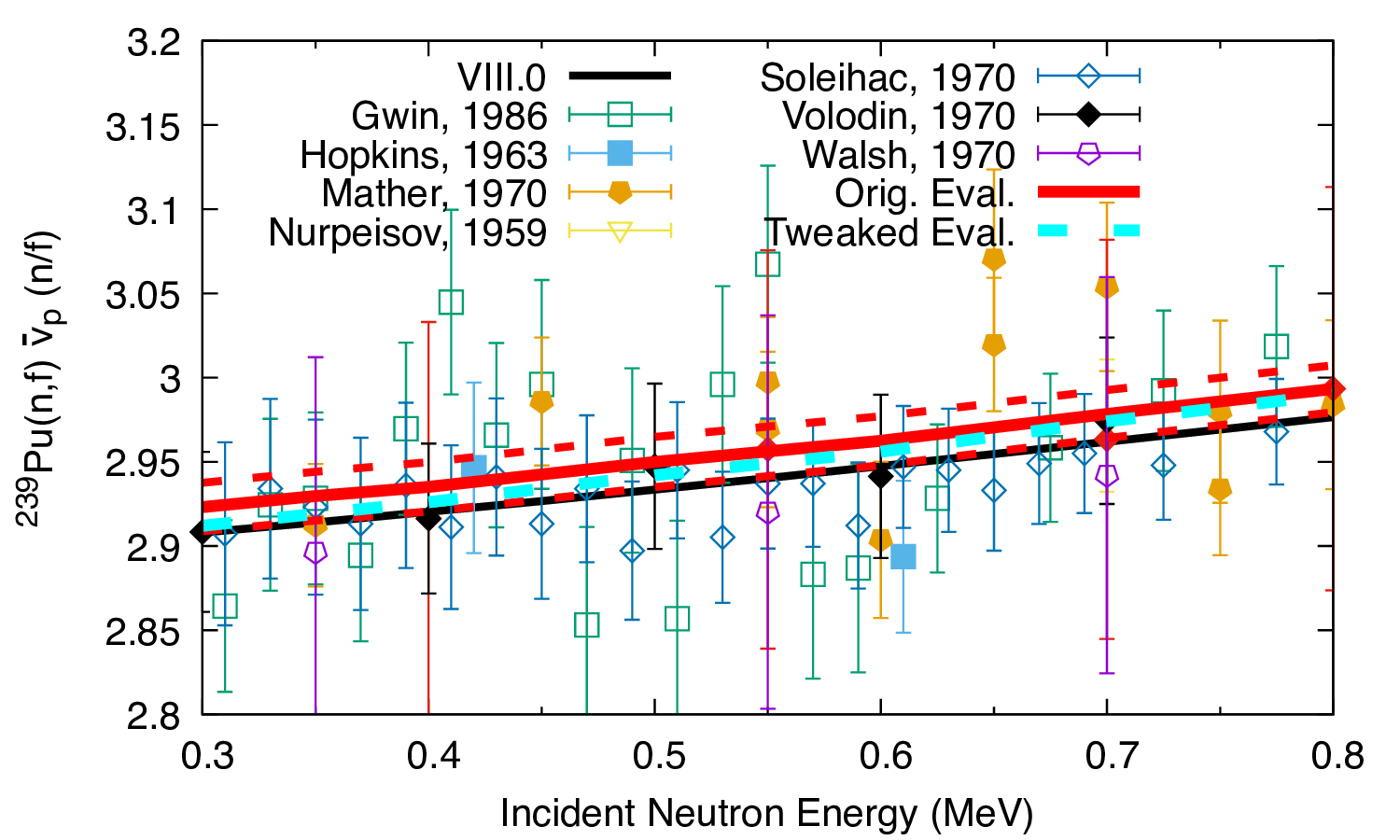
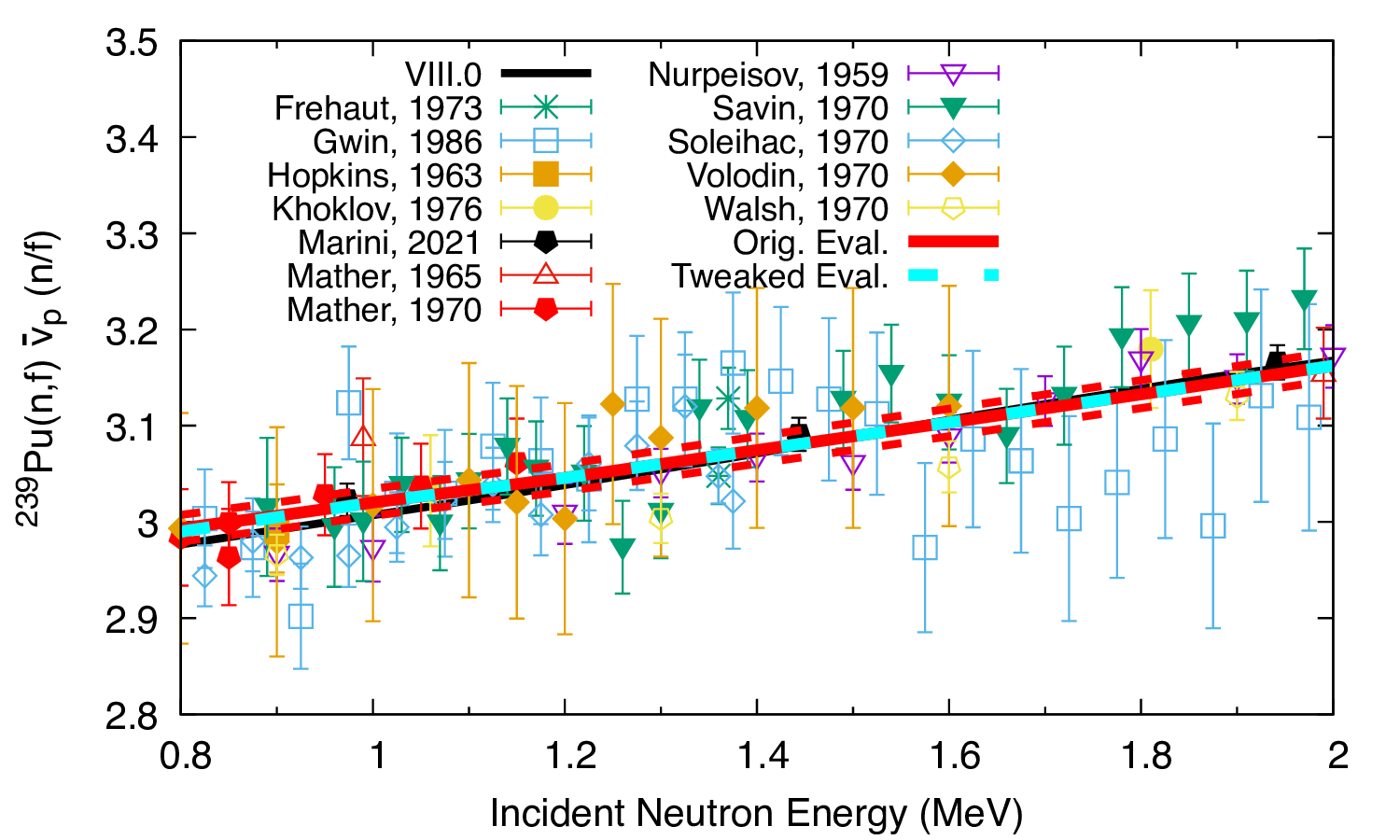
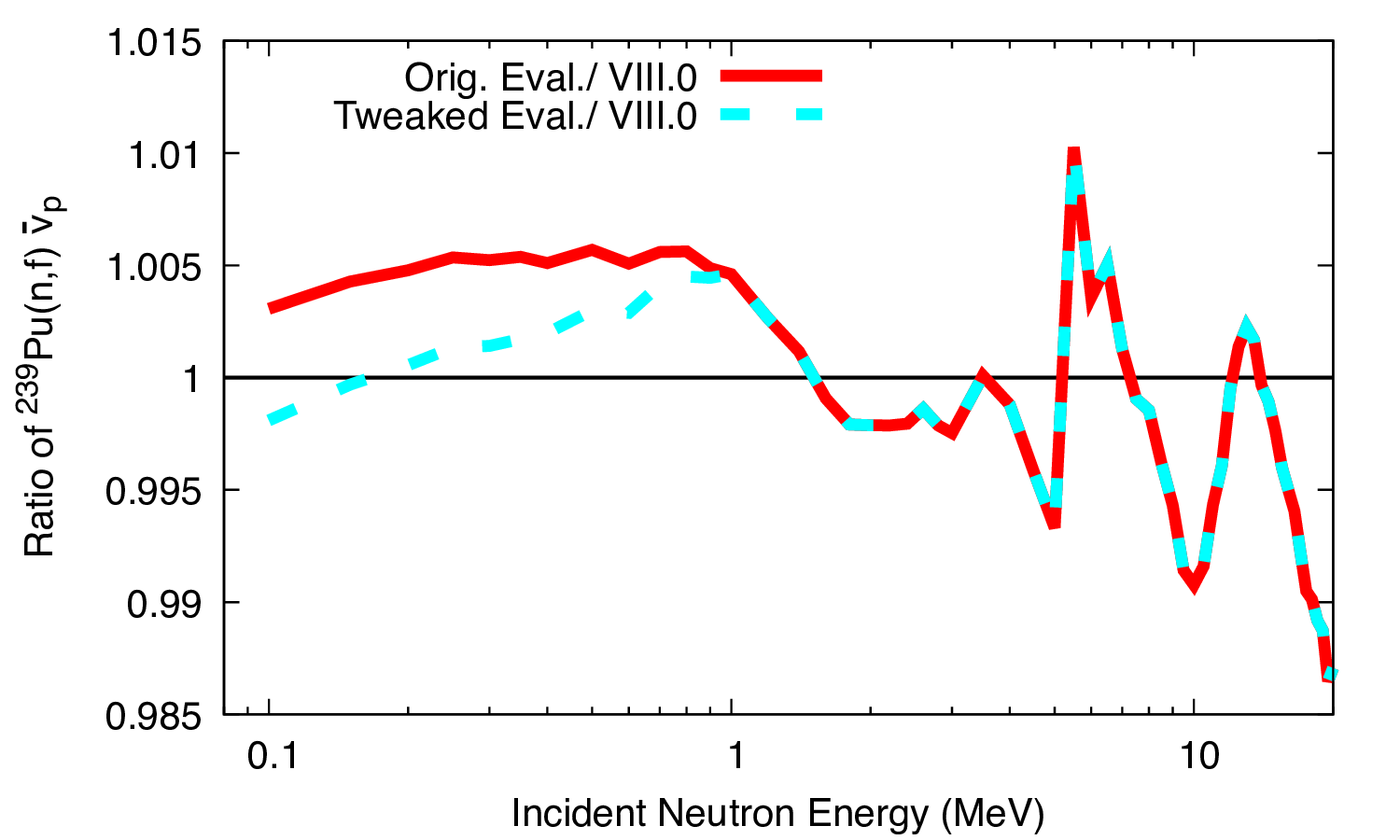
Requires small additional tweak since presentation at mini-CSEWG (2021) improving $k_{\textrm{eff}}$ performance
Nu-bar includes CGMF modeling, Marini data (measured with Chi-Nu array) and better experimental UQ
PFNS

PFNS no change since mini-CSEWG (2021)
PFNS includes high precision Chi-Nu and CEA data both measured with Chi-Nu array
Validation of our new $^{239}$Pu file is ongoing

We are testing LANL and INDEN (p35, p38) files
PU-MET-FAST, PU-MET-INT critical assembly $k_\mathrm{eff}$
Reaction rates in Jezebel and 3 Pu LLNL pulsed spheres
$^{235,238}$ U PFNS and (n,f) cross section
Work is ongoing as part of the Neutron Data Standards effort to update covariances of past experimental data related to $^{235,238}$U(n,f) cross sections in GMA; $^{238}$U(n,f) cross sections could be included in ENDF/B-VIII.1
$^{235}$U PFNS: work is currently ongoing to include new Chi-Nu data, work by A. Lovell, D. Neudecker & P. Talou also underway to model via CGMF (challenging)
$^{238}$U PFNS: Chi-Nu data scheduled to be coming shortly before the release of ENDF/B-VIII.1
Working towards update of $^{235}$U(n,f) $\overline\nu_p$
(experimental data only)

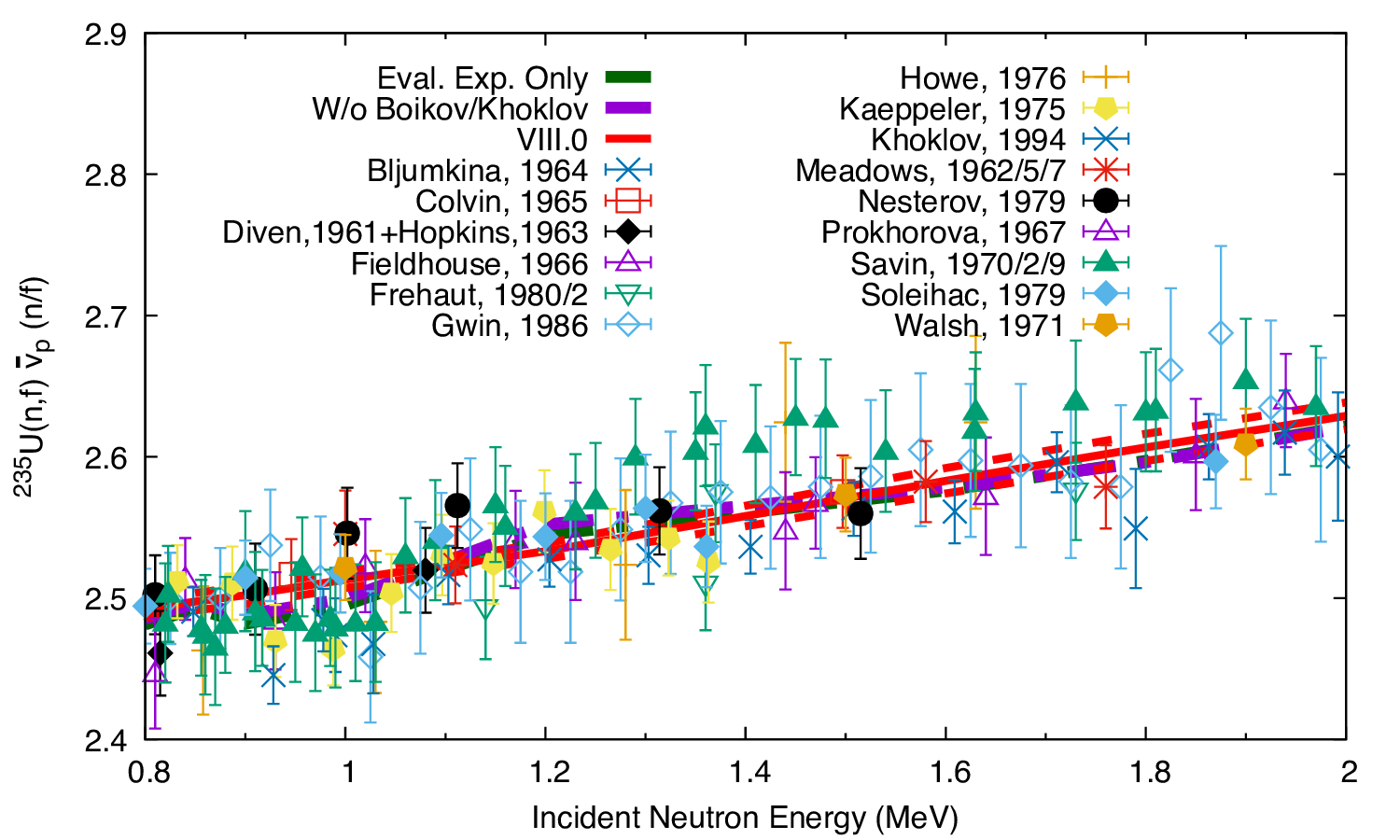
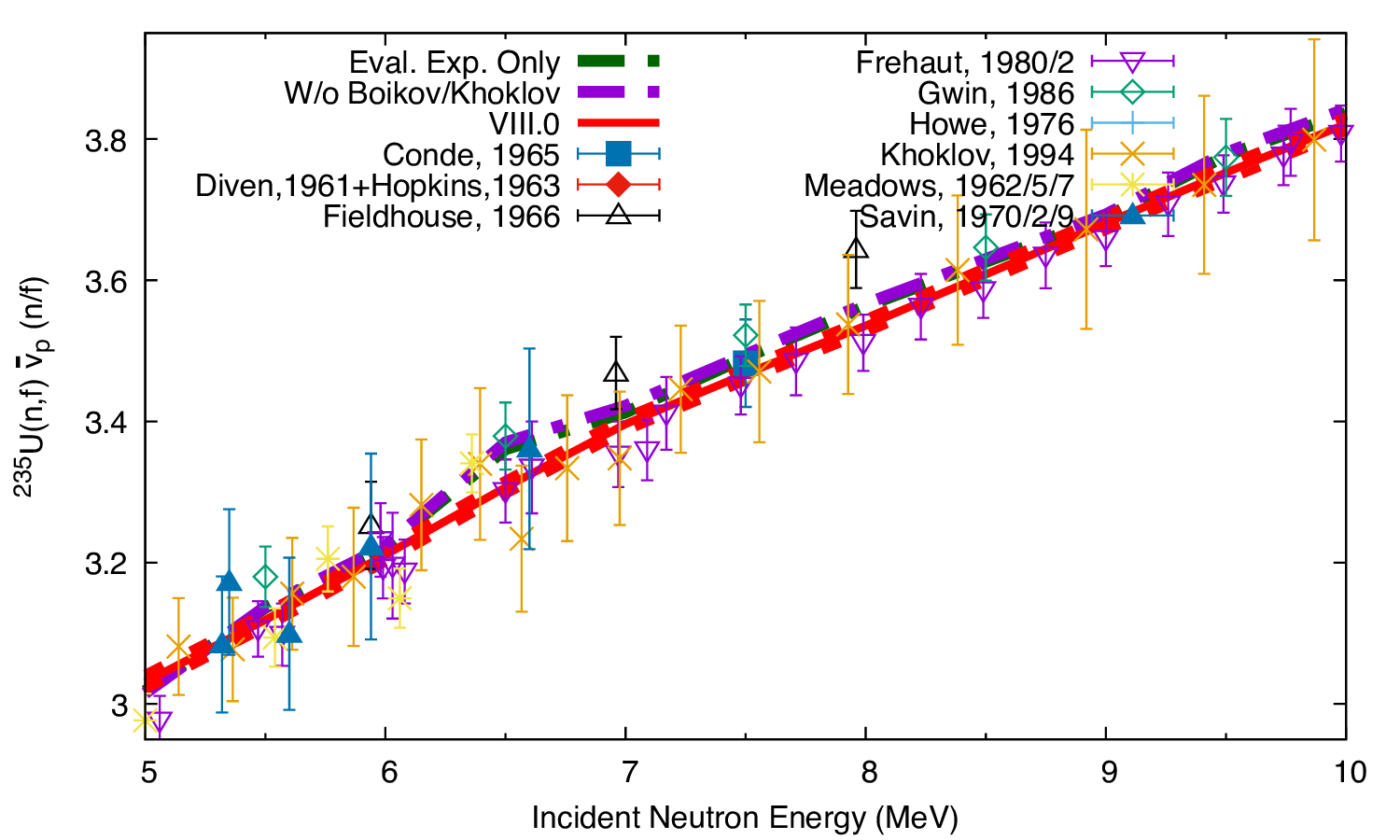
Started evaluation from scratch (no input files from Phil Young found), uncertainties of experimental data were re-estimated using templates of expected uncertainties
New data since last ENDF/B evaluation: Boikov and Khoklov, Khoklov data pull evaluation down below 1 MeV
2nd chance fission threshold more clearly obsered
Evaluated uncertainties were increased compared to VIII.0 to account for newest standard uncertainties
Working towards update of $^{235}$U(n,f) $\overline\nu_p$
(including CGMF model)

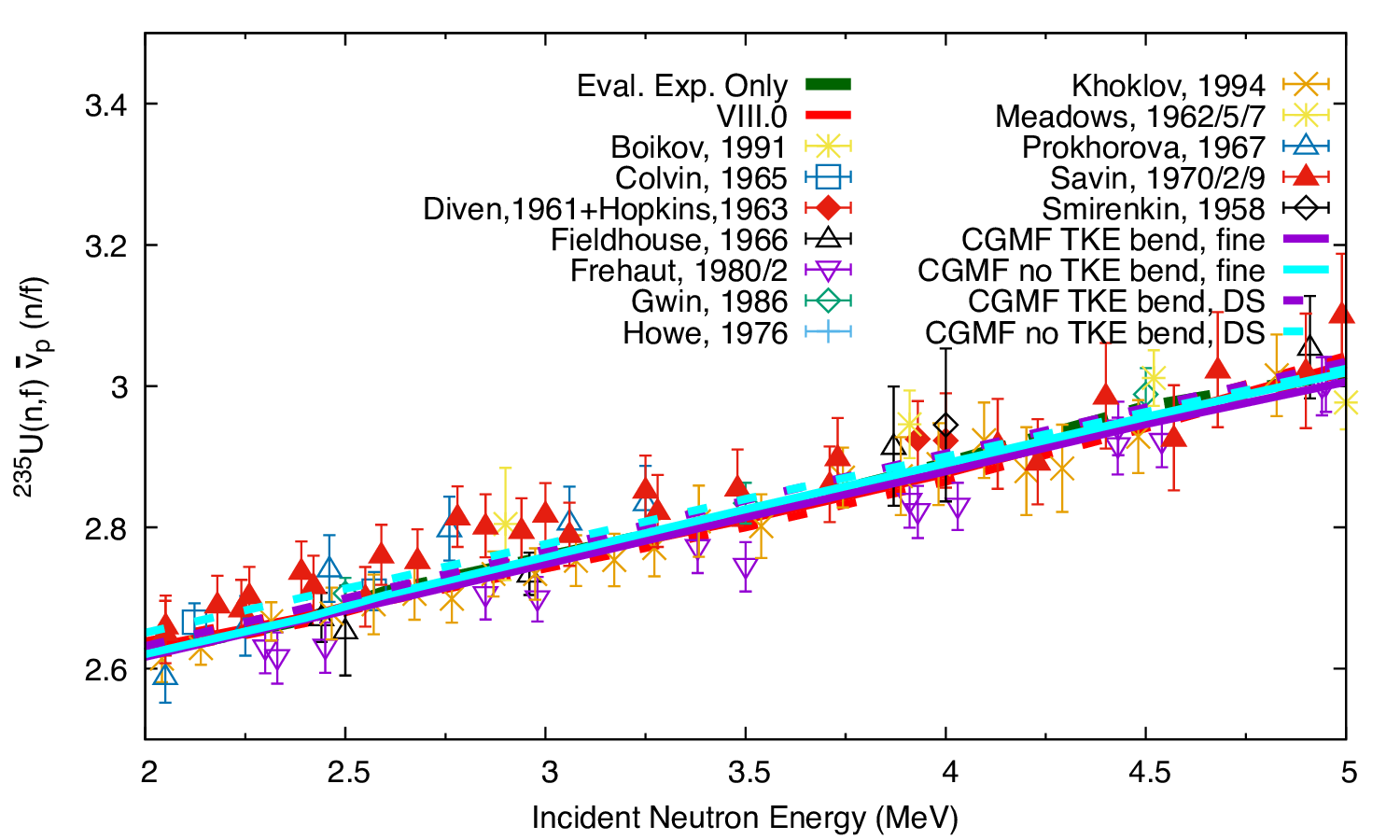
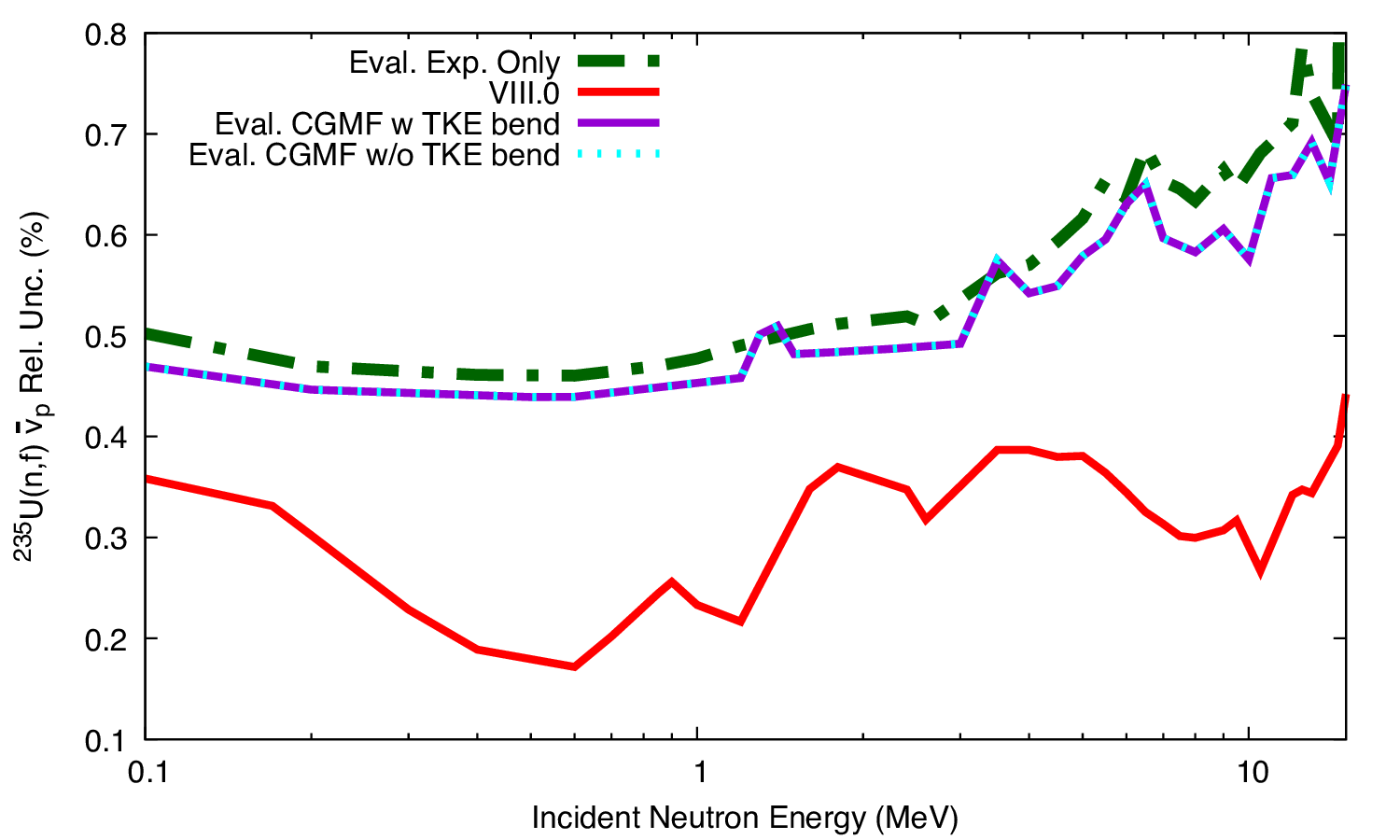
Including CGMF modeling (A. Lovell is doing the modeling)
Below 1 MeV: We are just exploring if there should be a bend in $\langle TKE \rangle$
Evaluated uncertainties increased compared to VIII.0 to account for newest standard uncertainties
Summary of current status: updates since ENDF/B-VIII.0
We are in the process of updating the $^{239}$Pu cross sections in the fast energy range
(complementing the work of IAEA / INDEN / ORNL lower energy work in the resonance range)
LANL has been overhauling its evaluation tools (CoH, CGMF, DeCE, Kalman, NEXUS, PySOK, SOK)
Focus on consistency throughout evaluation (we are evaluating more isotopes)
Model update: new collective enhancement allows for simultaneous description of (n,f) and (n,2n) channels
Model update: new inelastic scattering model using the Engelbrecht-Weidenmuller transformation
New cross section evaluation goes up to 30 MeV (as well as nu-bar and PFNS)
New (n,$\gamma$) data from S. Mosby up to ~1 MeV
Neutron Data standards $^{239}$Pu(n,f) cross section;
includes updates in covariances with templates and new (n,f) data from fissionTPC (Snyder)
New nu-bar including improved exp. UQ, Marini data and consistent CGMF modeling
New PFNS: INDEN non-model evaluation at thermal, Los Alamos model evaluation above including new Chi-Nu and CEA data
We are actively testing the file versus integral benchmarks; starting covariances
Special thanks to our colleagues
Roberto Capote, Mark Chadwick, Matt Devlin, Mike Herman, Toshihiko Kawano, Keegan Kelly, Amy Lovell, Paola Marini, Vladimir Pronyaev, Luke Snyder, Ionel Stetcu, Julien Taieb, Patrick Talou, Andrej Trkov
We gratefully acknowledge the support of the Advanced Simulation and Computing (ASC) program at Los Alamos National Laboratory.
This work was supported in part by the Nuclear Criticality Safety Program, funded and managed by the NNSA for the Department of Energy.